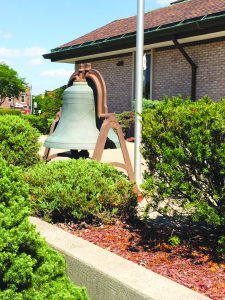The bells of early Wayne

Congregational Church bell.
By Darlene Hawley – In today’s world communication is almost instantaneous. Television and the internet connect us to every part of the world within minutes of a disaster, happening, phenomenon, tragedy, or happy event. Live coverage means we know every detail and live in the moment of these occurrences almost as if we were there. Our iPhones also give us instant connection to others. It boggles one’s mind to see what has become of the “telephone” of our childhood. A black box with a receiver that sat on the living room end table was the family phone. It could be used to make a call if the two or three other families on the line were not using it. When it rang, you counted the rings to see if it was for you or another household. Today, iPhones seem like magic. How do they work with no cords??? About fifteen years ago my husband and I were lucky enough to take a trip to Hawaii. I sat on a beach on one of the islands in the middle of the Pacific Ocean and called my daughter here in Michigan and marveled at the clarity of our conversation. Today we expect to make quick clear connections to someone any place on earth. Phones today are mini computers that can answer your questions on any topic, help you find your destination, entertain you with games, take pictures and videos and much more that I haven’t figured out how to use. Plus, it keeps you connected to family and friends.
If you look at the history of man, you can see how far communication has come in a very short time. Drawings on cave walls was the beginning. Smoke signals to pass along information came next and then a horn made from the horn of an animal. Then came the bell. The invention of the bell was by far the most important addition that helped people communicate with each other.
Bells date back to about 2000 B.C. in east Asia. Archaeologists have uncovered early bells in that area that were simple and made of pottery as well as more sophisticated ones made of metals. Europe began making bells in the 4th and 5th century. Early bells were made in pits by casting a copper and bronze alloy. Often, the tower was built over the pit and then the heavy bell attached to ropes and hoisted up to the top of the tower. The pitch of the bell is correlated to it’s size. In general, the bigger the bell the lower the pitch and the smaller the bell the higher the pitch. Fine tuning of early bells that were cast was accomplished by chipping away at metal inside the bell. In modern times bells are fine tuned with lathes which makes it easier to remove just the right amount of material to produce a true tone with correct harmonics. Some of the most famous foundries in the United States were the McShane Bell Foundry in Baltimore, the Revere Foundry, George Holbrook Foundry, and the Henry Hooper Foundry in Boston. There were and still are a number of bell foundries in Ohio, including The Buckeye Bell Foundry, the C.S. Bell Co., Meeks. Watson & Co. and the Verdin Co.
Not that long ago, when our little village and farming community was growing, there was only one form of communication. The bell. The church bell called us to church and the school bell called us to school. The teacher had a hand held school bell used to call the class to attention or announce the end of recess. For the wealthy, a bell was used to summon their servants. There was a dinner bell on the porch of the farm house which rang and called the men from the fields, the children from play, and the women from their quilting. Dinner was an important time for nourishment but also a time to share the happenings of the day and plan for coming days. The farmer hung a bell around the neck of the milk cow as she wandered around the farm, so he could find her when it was time for milking. If there was a fire in town or on one of the farms, the fire bell would ring loud and long to call for volunteers to come running with their buckets to help put out the fire. When the train came to Wayne it announced its arrival in the station with a bell. The conductor had a bell he used to board passengers on the train as it headed for the next station.
Today, bells are a novelty. Most churches do not use the bells housed in their towers but have chimes that are connected to their organs. They are primarily electronic. In our community of Wayne, St. Mary’s Church is the only church that still makes use of the bell hanging in its bell tower. The bell was made by the Henry McShane MFG Co. in Baltimore, Maryland in 1901. It is operated manually by someone assigned to ring the bell for mass or for a special event in the church. It has been rung to announce the death of a pope. According to Dr. Richard Schneider, the organist, choir and hand bells director for St. Mary’s as well as the music teacher for all of the children attending St. Mary’s school, Wednesday morning is a special time. The children are called to mass by the ringing of the bell and each week one lucky child gets to be the bell ringer. Pulling the rope at just the right speed and rhythm ensures a steady pealing of the bell. Dr. Schneider had me try ringing the bell as I visited the bell tower and then we imagined that many people in the area were perplexed as to why the bell was ringing at such an odd time.
If you look at the churches around our community you may see some large bells sitting in front of them. Each of these bells have a story to tell. The Congregational Church in downtown Wayne has a large bell sitting on its patio by the church entrance. The church was built in 1849 and a bell made by the Buckeye Bell Foundry of Ohio was placed in its tower in 1896. For many years this bell rang and called its congregation to worship. In 1970 the church burned while it was being prepared to be painted. The bell in the bell tower was cracked during the fire and could not be used again. The church was rebuilt on the same spot and the bell was mounted on a stand outside the church on display for all to see. Today the churches chimes and bells are electronic and ring on the half hour.
St. Michaels Lutheran Church, on the corner of Hannan and Glenwood, has a bell sitting next to their main entrance. This bell has a story to tell. St. Michael’s original church was built in 1962 without a bell or bell tower. In 1979 an addition was added to the church. In 1982 they opened their school. The bell sitting at their entrance was first used in a church built on a farm on Sumpter Rd. in Belleville. When the church was torn down, the bell was left sitting in the field. It next went to St. Paul Luthern Church in Belleville. That church eventually gave the 100 year old one ton bell to a man who donated it to St. Michael’s Church. Church members at first thought they would build a bell tower for it but later decided to place it where it is today. The bell was made by the C.S. Bell Company from Hillsboro, Ohio.
The Methodist Church in downtown Wayne has a bell sitting in a brick bell tower on the south east corner of its property. The Methodist Church was organized in 1826 and was Wayne’s first church organization. Members met in homes and buildings and shared the Congregational Church after it was built in 1849. In 1862 they built their own church with a bell tower and bell. In 1929 this church was condemned and torn down and a new church erected but the bell was saved. In 1983-84 a new addition was added to the church and the bell that had been ringing for many years was removed. A few years later Jim Sutcliff, a church member, built a new bell tower to display the old bell. It was a replica of the old tower in the first church. The weather caused the wooden structure to deteriorate. In 2006 church members Izzie Leseur and Mike Szabo worked with others to rebuild the display tower in brick to house the historic bell.
On display in our Wayne Historical Museum is the bell that first called children to school in 1871 at the old Union School. It was made at a bell foundry in West Troy, New York. In 1909, when the three story Union School was demolished and a new brick building named Roosevelt School was built, the bell was moved to that building. It was used to call children to school for some 90 years until it was donated to the Historical Society around 1962 and placed in the museum.
I have not mentioned hand bells and bells used in orchestras and bands that communicate beautiful music to us but I’m afraid that is another story and I am out of space.
(Thanks to Dr. Richard Schneider for his help with this article.)




